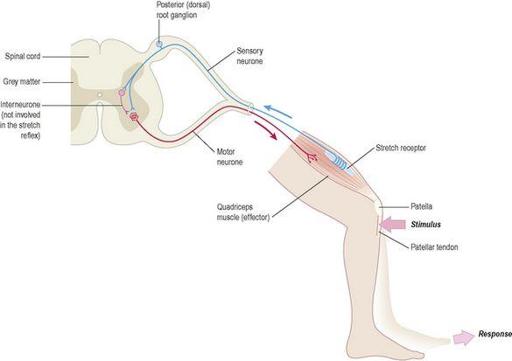Ross & Wilson Anatomy and Physiology in Health and Illness (73 page)
Read Ross & Wilson Anatomy and Physiology in Health and Illness Online
Authors: Anne Waugh,Allison Grant
Tags: #Medical, #Nursing, #General, #Anatomy

The lower motor neurone is the
final common pathway
for the transmission of nerve impulses to skeletal muscles. The cell body of this neurone is influenced by a number of upper motor neurones originating from various sites in the brain and by some neurones which begin and end in the spinal cord. Some of these neurones stimulate the cell bodies of the lower motor neurone while others have an inhibiting effect. The outcome of these influences is smooth, coordinated muscle movement, some of which is voluntary and some involuntary.
Involuntary muscle movement
Upper motor neurones
These have their cell bodies in the brain at a level
below
the cerebrum, i.e. in the midbrain, brain stem, cerebellum or spinal cord. They influence muscle activity that maintains posture and balance, coordinates skeletal muscle movement and controls muscle tone.
Table 7.2
shows details of the area of origin of these neurones and the tracts which their axons form before reaching the cell body of the lower motor neurone in the spinal cord.
Table 7.2
Extrapyramidal upper motor neurones: origins and tracts
Spinal reflexes
These consist of three elements:
•
sensory neurones
•
connector neurones (or interneurones) in the spinal cord
•
lower motor neurones.
In the simplest
reflex arc
there is only one of each (
Fig. 7.31
). A
reflex action
is an involuntary and immediate motor response to a sensory stimulus. Many connector and motor neurones may be stimulated by afferent impulses from a small area of skin, e.g. the pain impulses initiated by touching a very hot surface with the finger are transmitted to the spinal cord by sensory fibres in mixed nerves. These stimulate many connector and lower motor neurones in the spinal cord, which results in the contraction of many skeletal muscles of the hand, arm and shoulder, and the removal of the finger. Reflex action happens very quickly, in fact, the motor response may occur simultaneously with the perception of the pain in the cerebrum. Reflexes of this type are invariably protective but they can occasionally be inhibited. For example, if it is a precious plate that is very hot when lifted every effort will be made to overcome the pain to prevent dropping it!
Figure 7.31
A simple reflex arc involving one side only.
Stretch reflexes
Only two neurones are involved. The cell body of the lower motor neurone is stimulated directly by the sensory neurone, with no connector neurone in between (
Fig. 7.31
). The
knee jerk
is one example, but this type of reflex can be demonstrated at any point where a stretched tendon crosses a joint. By tapping the tendon just below the knee when it is bent, the sensory nerve endings in the tendon and in the thigh muscles are stretched. This initiates a nerve impulse that passes into the spinal cord to the cell body of the lower motor neurone in the anterior column of grey matter on the same side. As a result the thigh muscles suddenly contract and the foot kicks forward. This is used as a test of the integrity of the reflex arc. This type of reflex has a protective function – it prevents excessive joint movement that may damage tendons, ligaments and muscles.
Autonomic reflexes
These include the pupillary light reflex when the pupil immediately constricts, in response to bright light, preventing retinal damage.
Peripheral nervous system
Learning outcomes
After studying this section you should be able to:
outline the function of a nerve plexus
list the spinal nerves entering each plexus and the main nerves emerging from it
describe the areas innervated by the thoracic nerves
outline the functions of the 12 cranial nerves
compare and contrast the structures and neurotransmitters of the divisions of the autonomic nervous system
compare and contrast the effects of stimulation of the divisions of the autonomic nervous system on body function.



